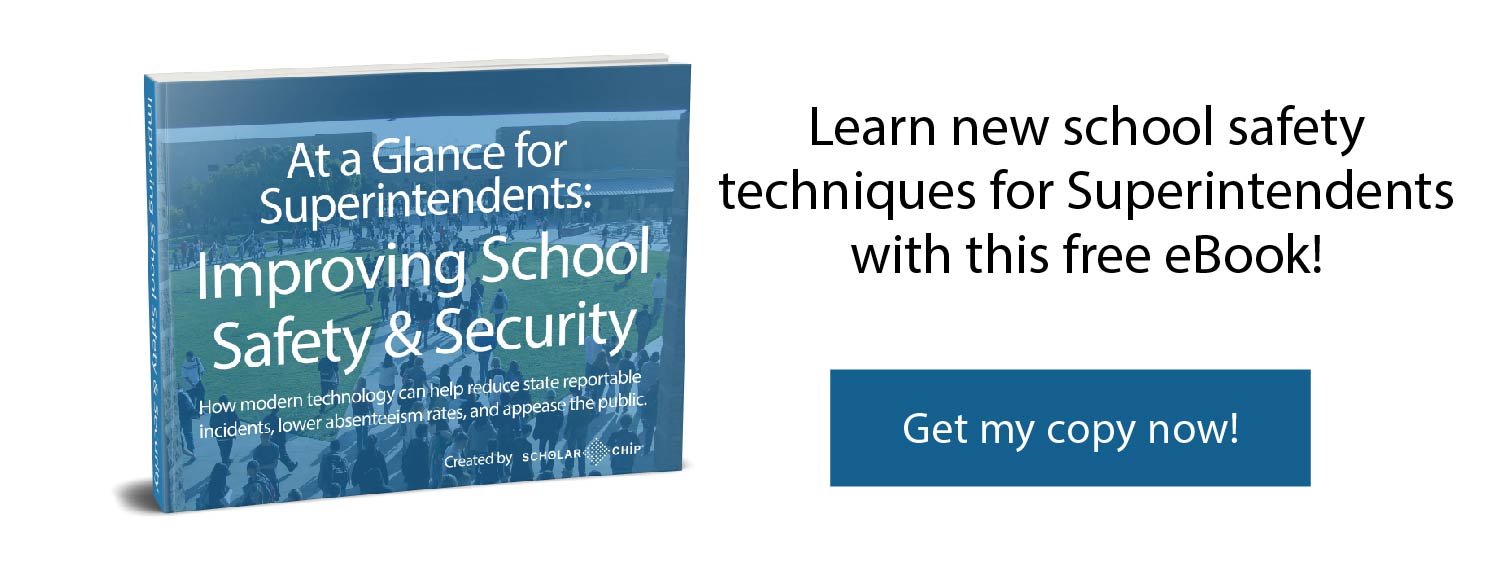Of the 3,000-plus bills introduced in the California legislature this past year, few made it to the governor’s desk, let alone into law.
Still, as a school administrator, you’re challenged with the task of learning how any new California school safety laws may help or hinder your ability to quickly meet each mandate. Finding an all-in-one solution that pairs perfectly with next year’s school safety plan can seem overwhelming, especially as the new state laws begin to focus on the importance of students’ social and emotional learning.
Statewide school administrators are now turning to a modernized solution to streamline their staffs’ tasks and leverage a solid school safety plan that:
- Meets new modernization mandates
- Evolves with technology
- Remains compliant with California school safety laws—and data security concerns.
As the state of California shifts its attention toward social/behavioral impacts, so can your school safety plan.
This guide will provide insight to school administrators about new and revised California school safety laws and more critically, how they will impact current school safety plans—and school years to come.
The Top 10 California School Safety Laws Worth Knowing about—and How to Be Ready
New Positive School Climate and Training Laws: What Will Impact Your Staff and Students
#1. SB 390 Security Training Mandate: All School Security Officer
All security guards working on school and community college district campuses, including part-time workers, must now complete safety training.
“Students face complex and unfortunate challenges every day, such as bullying, gun violence, gangs, and drug abuse. The support provided by school security officers is an integral part of our public school system. They build a relationship of trust with our students, and teach them about personal safety, tolerance, and the importance of personal achievement,” said Senator Tom Umberg. “Ultimately, the goal of SB 390 is to fully commit all school safety officers to student safety, by maximizing preparedness and knowledge essential to keeping children safe.”
It is clear that California school safety laws have already begun to underline the importance of the social and emotional security of students by mandating specialized training for both full- and part-time school security officers, with a strong emphasis on relationship-building and personal achievement—aside from mere gun laws.
Therefore, school administrators must have an all-in-one solution that helps onboard staff and part-time officers accurately/securely keep track of staff and student data, including the progress of their expanded security training.
#2. AB 493 Positive Student Inclusion: LGBTQ+ Training for California Teachers
AB 493 requires the training of school staff at least once every two years for the support of lesbian, gay, bisexual, transgender, queer, and questioning pupils. The state’s attention toward a positive school climate has now positioned all California school administrators to take a more meaningful approach to awareness and inclusion.
Consequently, an SIS integration that not only delivers ease of data management but also helps mitigate concerns of sensitive data protection is an extremely imperative part of the new staff training needs.
#3. AB 265 Pupil Meals: No Shaming
Schools must ensure that a pupil whose parent or guardian has unpaid school meal fees is not denied a reimbursable meal of the pupil’s choice and ensure that the pupil is not shamed or treated differently from other pupils.
New Mexico State Senator Mike Padilla was a victim of lunch shaming. As a foster child, he was forced to wash cafeteria floors while his peers watched. Senator Padilla states, “It was very obvious who the poor kids are in school.”
California recognizes that such barbaric practices must stop in all schools.
Fortunately, Smart ID card technology offers an all-in-one solution that can help secure confidentiality, prevent embarrassment, and avoid bullying. It is equally important to ensure that your school gains a modernized system that protects their privacy and helps them succeed socially and emotionally.
#4. SB 328 Mandating Late-Start Times for Older Students
SB 328 now impacts both traditional and charter schools. It requires schooldays for middle and high schools to begin no earlier than 8:00 am and 8:30 am, respectively, by July 1, 2022, or the date on which a school district’s or charter school’s respective collective bargaining agreement that is operative on January 1, 2020, expires, whichever is later, except for rural school districts.
This California school safety law now requires the State Department of Education to take a closer look at the social and emotional outcomes of California adolescents by performing research on the impact of sleep deprivation and the benefits of a later school start time.
Ease Your Staff and Student Concerns with Smart Card Technology
Great news! SB 328 requires the state to reimburse these schools for certain costs mandated by this California school safety law. Now is the time to modernize your school safety plan and mitigate your worries about costs.
Smart card reader technology can provide an all-in-one solution to California school administrators seeking to adhere to this mandatory law, boost school security, offer real-time data, and help manage any school population size—no matter when they arrive and exit.
#5. AB 272 Smartphones: The Law That Helps Your Staff Manage Behavior and Focus
AB 272 now authorizes school districts to prohibit its pupils’ smartphone use on the premises, besides specific circumstances. The state of California is beginning to focus more attention on school climate and socio-emotional/behavior (aside from gun violence alone).
Furthermore, the State has evidence that unrestricted behaviors (such as smartphone usage) contribute to an increase in teen anxiety and suicide.
Behavior and Discipline: Your School Enrollment and Safety
#6. SB 419 Pupil Discipline: No More Willful Defiance Suspensions
Commencing July 1, 2020, SB 419 prohibits the suspension of a pupil enrolled in a school district or charter school in Grades 4 and 5 for disrupting school activities or otherwise willfully defying the valid authority of those school personnel engaged in the performance of their duties.
The new expanded suspension law for California schools, from July 1, 2020, until July 1, 2025, will prohibit the suspension of a pupil enrolled in a school district or charter school in any of Grades 6 to 8, inclusive, for those acts.
In order to be successful, school psychologist and the Department of Education are recommending a behavioral management system, which usually has many of the following elements:
- A total staff commitment to deploying and using a system to manage behavior
- Well-defined and articulated rules, expectations, procedures, and consequences
- Student instructional content to teach self-control and social skills
- Support resources for students with chronic and challenging behavior
As a reminder, procuring a robust all-in-one solution provides not only ID management but also ABE (Alternative Behavior Educator), helping prevent and intervene in those situations that cause suspensions in the first place. ABE teaches better behavior and monitors progress throughout a student’s career. It gives principals, teachers, and administrators specific data-driven reports surrounding behavior management of a student and flags possible at-risk students. The program also provides a reward system when a student meets the requirements.
#7. AB 1127 Transfers Due to Bullying
AB 1127’s new mandatory adherence illustrates how California schools must approve an intradistrict transfer request for victims of bullying acts. This school safety law requires this until maximum capacity is met.
As an advantage, a modernized all-in-one solution provides synchronized, real-time data on all schools within each school district and empowers school administrators to easily verify school populations and effortlessly make the necessary data transferable/accessible/secure to the staff at the next school.
Your Students’ ID Cards and School Websites: What You Need to Know
#8. SB 316 ID Card Mandate: Resources on Domestic Violence, Sexual Harassment
SB 316’s new ID card requirement demands all schools to have a domestic violence hotline telephone number.
Fortunately, the innovation of smart ID cards into your modernization project gives you the ease of upgrading all staff and students’ ID cards to dually meet the SB 316 and exceed other California school safety laws. It is critical to partner with the best integrated security and operation service provider that offers the card designs that meet and keep up with California school safety laws each year.
#9. AB 34 Website Mandate: Bullying and Harassment
Through the AB 34, all schools are immediately required to display easily accessible resources on their existing website about bullying, harassment, suicide, and other acts of violence/discrimination.
A Long-Term Training Resource That Meets and Exceed AB 34
With the ABE’s impact on students, staff, and parents to work closely in real time toward preventing and intervening behavioral challenges, AB 34 resources can be integrated through the all-in-one solution data center platform. Not only are AB 34 resources integrated and readily available on the school’s website, but an effective SIS (Student Information System) and strong SSOS (School Safety & Operation System) can improve school operations and reduce costs. These also play a critical role in managing—and protecting—student demographics, scheduling, grading, and monitoring academic performance.
Funding and Modernization: How AB 48 Benefits Your School’s Current—and Future—Safety Plan
#10. AB 48—More Money for School Modernization: $15-Billion State Bond for Schools and Universities
As an added benefit to this year’s California school safety law changes, affording a school modernization project is much simpler—and more achievable. However, the grants and reimbursements are only possible through your school’s efforts and success in obtaining an all-in-one solution toward school safety that targets both physical and social/emotional wellness.
The AB 48 (Reimbursement from the State for Certain Costs) existing law prohibits the total amount of bonds issued by a school district or community college district from exceeding 1.25% of the taxable property of the district, as provided.
This bill raises that limit to 2%—and 4% for unified school districts.
Remain One Step Ahead: Gain the Right Tools for a Safer School
As the most trusted integrated security and operation service provider, ScholarChip boasts no major or minor security breaches in several years of continuous application delivery. ScholarChip’s overall school safety system converges and integrates all security needs, meets and exceeds the plethora of evolutions in state and federal legislation, and harnesses technology advancements into one scalable approach for the best results.
ABE works in tandem with the “smart” identification cards given to students and staff. Your school can control building and door access privileges by only allowing passage through certain doors at a specific time. This is a smart solution to manage attendance and create accountability for your students, while meeting California school safety law goals to help cultivate a positive school environment.
Take the next step to remain one step ahead of your school’s safety challenges and state laws. Learn more about ScholarChip’s school behavior and safety solutions by contacting us today.


